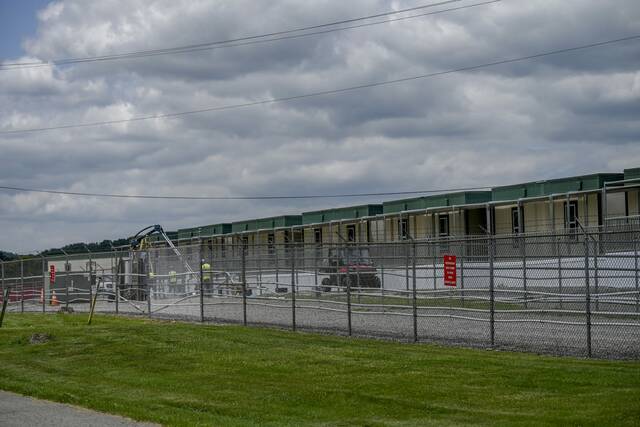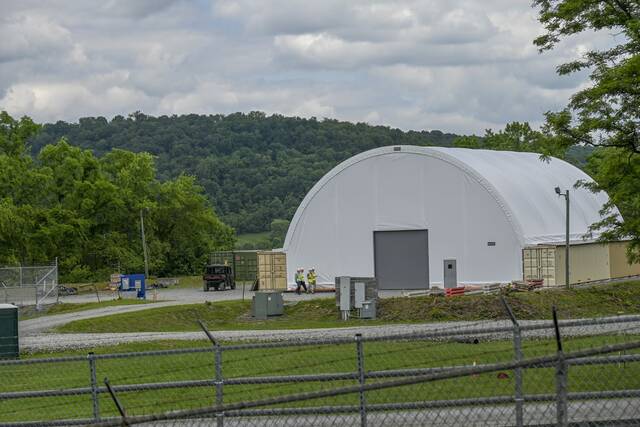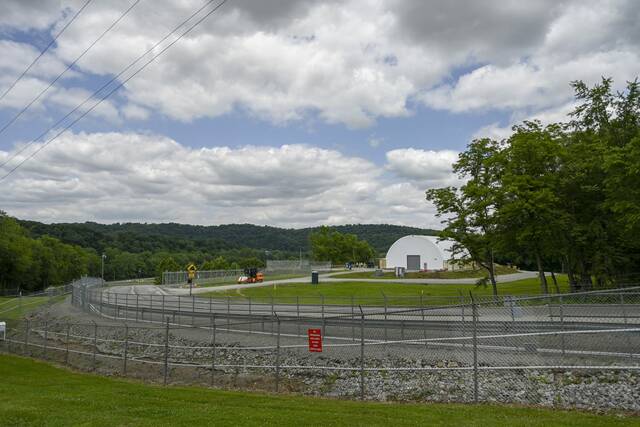U.S. Army Corps of Engineers says removal of nuclear waste from Parks Township dump to start next summer
Remediation of a nuclear waste dump in Parks Township remains on schedule — to start next summer and have all of the material removed to Utah six years after that, U.S. Army Corps of Engineers officials said.
The Army Corps gave the update at a public meeting Tuesday at the township’s volunteer fire hall.
The 44-acre site, named by the feds as the Shallow Waste Disposal Area, is located along Route 66 near Parks’ Kiskimere neighborhood. From 1960 to 1970, Nuclear Materials and Equipment Corp. (NUMEC) dumped and buried radioactive waste there. There are 10 trenches of contaminated waste at the site.
Tuesday’s meeting, which drew about 60 people, gave an update on the site’s progress and also answered questions and concerns raised during a September public update.
The Corps expects remediation work, starting with trench excavation, to begin in summer 2025. Officials have already begun to prepare the site for remediation.
Since September, the Corps has completed about 90% of its remediation design, and finished background radiological and geophysical surveys of the entire site, said Steven Vriesen, project manager.
Its also installed administrative office trailers and a temporary wastewater treatment plant, provided site-specific training to local first responders and established recurring meetings with the state’s Department of Environmental Protection and U.S. Environmental Protection Agency.
People near the site will continue to see more vehicle traffic, workers and maintenance activities over the next year, Vriesen said.
There is also additional construction planned, which includes a laboratory and buildings to enclose future trench excavations and to process excavated material for off-site shipment.
Remediation is scheduled to last about six years, Vriesen said.
“The ultimate duration will be determined by the rate at which we can safely remove and characterize the waste,” Vriesen said.
Waste will be loaded in soft-sided packages inside buildings at the site, Vriesen said.
The packages will be placed in bulk containers for transport to the Alaron Transload Facility on Wampum, Pa., about 60 miles northwest of Parks Township. Once in Wampum, the bulk containers will be transported by rail to EnergySolutions Clive Disposal facility in Utah.
“During remediation, we anticipate up to six waste shipments per week, consisting of three trucks making two shipments each per day,” Vriesen said. “And we expect waste shipments to occur two days per week.
”That’s 12 total waste shipments spread over two days of each week,” he said.
The Corps will stand by its plan to not cover three of 10 trenches during remediation, Vriesen said, after investigating the situation after concerns were raised last fall.
“The primary function of the excavation cover over trenches 1, and 4 through 8, is to ensure that workers can continue remediation year ‘round by protecting them, the equipment, and the excavations from inclement weather,” Vriesen said. “The cover is not intended to be a safety manager, but rather it allows our work to continue through multiple construction seasons without having to shut down during the winter.”
All 10 trenches can be safely remediated without a cover, as determined by a geophysical survey, Vriesen said. He confirmed the remedial design is protective of workers and the community.
“The survey confirmed that, based on the volume of material remaining in trenches 2, 3 and 9, those trenches can be remediated in less than four months, or rather in one construction season,” Vriesen said.
Vriesen said the Corps’ conducted two human health assessments to determine risks associated with consuming meat from deer living at the site and deer carrying contamination off-site if it were to enter an open trench during remediation.
“These assessments concluded that there is an insignificant risk to human health from consuming deer harvested from the site and an insignificant risk to human health for deer carrying contamination off of the site,” he said.
“However, to enhance the safety of our workers and the public, and to reduce the potential for animals to enter the trenches, we have decided to add fencing with a wooden screen around trenches 2, 3 and 9. This fence will add a layer of protection against animals entering the trenches, in addition to the double perimeter fence that already exists around the site.”
The Corps’ will begin remediation with the trenches enclosed in an excavation building.
“By doing that, starting remediation of trenches 4 through 8 will provide us with data to demonstrate that the remedial operation is safe and protective of site workers and the community,” Vriesen said.
Ashley Pomaski, an environmental engineer with the Corps’ Buffalo (N.Y.) District, said eight perimeter air monitors and one off-site background monitor have operated continuously since 2011; and the Corps has also installed an additional perimeter air monitoring station along the site border.
It also added beryllium air samplers at all nine on-site and one off-site air monitoring stations, she said.
“The Corps of Engineers is also developing a site infographic that will summarize our air monitoring programs, and present perimeter air monitoring results,” she said. “This report will be posted to the project website and will be updated as new data becomes available.”
The Buffalo District is assisting the Pittsburgh Corps with the cleanup because it has experience managing FUSRAP (Formerly Utilized Sites Remedial Action Program) projects like the one at Parks Township. Buffalo is currently remediating eight FUSRAP sites across the Northeast, said district Commander Lyle Milliman.
“We have a very robust team that’s very capable,” Milliman said. “We do this day in and day out across the Northeast, and then we’re going to continue to do it down here in the Pittsburgh area.”
The Corps’ increasing the contract from $350 million to $500 million hasn’t slowed down work, nor does it plan to, Vriesen said.
The Corps in December announced it was issuing a “sources sought notice” for market research and planning for the cleanup at the site, as it realized the $350 million limit on the current contract would be insufficient to complete the work.
“Our goal is to have that new contract awarded by fall of 2025,” he said.
Corps’ public affairs officer Carol Vernon stressed the feds would prioritize safety, security, transparency and community involvement throughout remediation.
The Corps plans to hold public information sessions once every six months, she said.
Kellen Stepler is a TribLive reporter covering the Allegheny Valley and Burrell school districts and surrounding areas. He joined the Trib in April 2023. He can be reached at kstepler@triblive.com.
Remove the ads from your TribLIVE reading experience but still support the journalists who create the content with TribLIVE Ad-Free.



